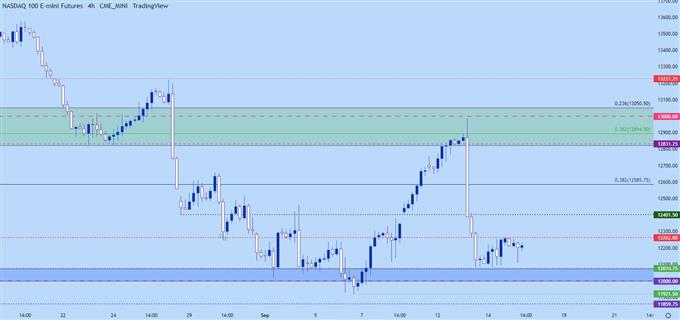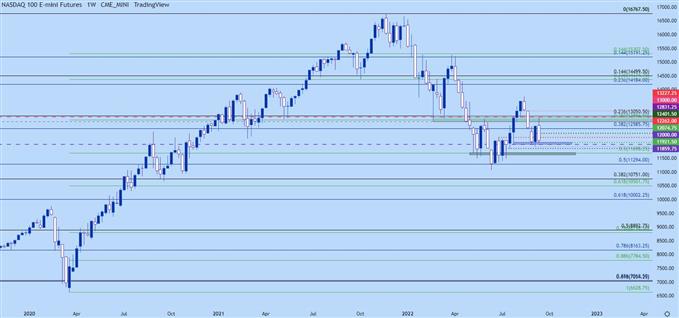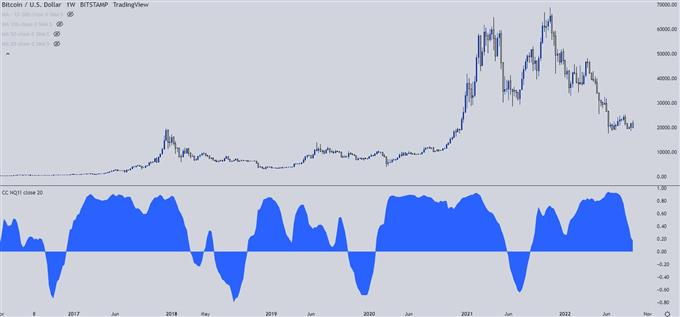Grinding support as USD, FOMC Drive the Waves
Nasdaq, Bitcoin Talking Points:
- Both Nasdaq and Bitcoin are testing key support points after aggressive selling.
- It has been a brutal 2022 for Bitcoin but much of that pain was relegated to the first half of the year. Things haven’t been much prettier in the Nasdaq, and both are sitting on key support ahead of next week’s FOMC.
- When markets go into risk-off mode, we will often see correlations adjust, but that doesn’t mean the correlation is going to last and thus makes it difficult to plot strategy around it.
- The big driver of both bearish trends has been higher interest rates, and this is something that may remain until we reach a point of capitulation at the Fed.
- The analysis in the article depends on price measures and map formations. To learn more about price action or chart patterns, check out our DailyFX Education section.
Recommended by James Stanley
Download our USD forecast
Bitcoin is back to a very important zone of support. I’ve been tracking this for the past few months since it was the first area to finally stop the bleeding from the March-June sales. This goes from the 2017 swing high of $19,666 down to 78.6% Fibonacci retracement of the big move 2020-2021.
Bitcoin weekly price chart

Chart prepared by James Stanley; Bitcoin on Tradingview
When this area came into play in March, buyers slowly returned to the market as a bullish channel built. But given the pace of the previous sale the bullish channel was a bear flag formation, and it began to ease in late August, about a week before Chairman Powell’s speech in Jackson Hole. Interestingly, it is also around that time sellers began to fight back on the Nasdaq after a two-month rally from June lows.
Bitcoin dipped back into the support zone in early September, but soon found support in late June, leading to a bounce that led to this week’s trading – right up until Tuesday’s CPI release. And, like the Nasdaq, both markets were pummeled on the back of that data. But – interestingly Bitcoin is holding a higher-low at this point – above the swing from last week – just like the Nasdaq.
Bitcoin daily chart

Chart prepared by James Stanley; Bitcoin on Tradingview
Bitcoin short term
The $19,666 level was in play again yesterday, albeit in a very quick fashion. Buyers quickly returned and prices jumped back above the psychological level of $20,000. However, since then, there has been a trend to lower highs, setting the stage for a short-term descending triangle. It is a bearish formation and this leaves the door open for another support test in the near term.
(note): While writing this report descending triangle break took place and now it looks for another support test around the $19,666 level. If bears can push below that, with a lower-low, we will have a new lower-low and lower-high corresponding to a bearish short-term price action trend. The next support would be the late June low that helped provide a bounce last week.
Bitcoin hourly chart

Chart prepared by James Stanley; Bitcoin on Tradingview
Nasdaq
I looked into the Nasdaq on Monday so this will be relatively short compared to Bitcoin. And after all, there is some similarity here, so there’s no point in rehashing.
Like Bitcoin, the Nasdaq hit its all-time high last November. November is key, because that’s also when FOMC Chair Jerome Powell floated the idea of ”retiring” the word temporarily. Until then – the Fed had shrugged off ever-higher inflation of 5 or 6%, saying instead that the price increases were due to supply chain problems. Well, these supply chain problems never abated and on Tuesday inflation came in at 8.3%.
There is some real concern about this. Previous examples of increased inflation have shown that it is a difficult problem to tame. Once the trend begins, there aren’t many ways to slow it down other than raising interest rates to pull capital out of the system. And the very nature of doing so means that leverage is under pressure, because higher interest rates mean higher borrowing costs and also a greater opportunity cost of that capital.
After all, the big reason for keeping interest rates low is to stimulate investment to drive economic growth. And that is exactly what has happened for much of Bitcoin’s life, and for most of the last 13 years for Nasdaq. So, as the relationship goes the other way with the Fed’s aim to tighten, both markets see bearish scenarios.
In the Nasdaq, the big level at the moment is the 12k level. The price has not dipped – below that price since it rose – through July, and this remains a key point of support potential for bearish approaches. Resistance was in play earlier this week, just ahead of that CPI report and hovering around the 13k handle.
From the 4-hour chart below, we can see a lot of candlesticks just above the 12,074 level, and there is pretty clear evidence that buyers are coming in to support the declines.
Recommended by James Stanley
Get your free forecast for best trading opportunities
Nasdaq four-hour price chart

Chart prepared by James Stanley; Nasdaq 100 on Tradingview
Nasdaq bigger picture
This Tuesday there was a marked sell-off, and this is still reflected in the weekly chart. This also puts a lot of emphasis on support around 12k, as this week’s bar could still end as a bearish engulf, which would keep the door open to bigger picture bearish continuation scenarios ahead of the FOMC next week.
Even without the completion of the bearish engulfing, sellers will retain the appearance of control until they can push a lasting break above the August high.
Weekly chart for the Nasdaq

Chart prepared by James Stanley; Nasdaq 100 on Tradingview
Bitcoin and Nasdaq – the relationship
In my opinion, these are completely different markets and assets that have shared a relationship of being driven higher by low prices and exuberant risk taking.
And now it’s getting underway as the Fed has clearly set its sights on reducing inflation. And this is not something they can afford to miss, as past examples have shown that the problem only gets worse and worse, and the worse it gets, the higher prices have to go to finally eliminate the problem.
So while there will likely be a correlation between the two macro risk assets as the Fed raises rates, I expect the relationship to separate at some point, similar to what we saw in 2018 when the Fed was busy raising rates four times. That year saw capital continue to exit Bitcoin at a faster pace, to the point that a correlation coefficient of .89 in January dropped to -.8 in August.
Recommended by James Stanley
Building trust in trade
Bitcoin Weekly Chart – Correlation Coefficient to Nasdaq Futures

Chart prepared by James Stanley
Bitcoin and Nasdaq – longer term
I’m not a fan of being on the bearish side of markets. But I also recognize the necessity of at least trying to be objective. And I’ve been bearish on stocks for a while now, and that’s still the case today.
I am similarly bearish on short-term Bitcoin prices. But an important caveat – I’m also bullish on Bitcoin on a long-term basis, and if anything, I see this coming bearish scenario as a long-term spot of potential opportunity. And maybe the same can be said about the Nasdaq, but that picture seems a little scarier to me. In Bitcoin, it is the limited nature of the asset that makes it attractive in my eyes, and given the fact that the US government has not taken a stronger hand on the matter, indicates to me that there may remain some long-term opportunity once a bottom is reached place.
Where is that bottom, but that’s the big question? And really, I don’t know… I expect to see some sharp repricing in the markets, and the one expectation I have for bottoms is that they will appear when very few want to look at anything on the long side. And given the continued showing in Bitcoin (and Nasdaq) – we’re not there yet.
— Written by James Stanley, Senior Strategist, DailyFX.com and Head of DailyFX Education
Contact and follow James on Twitter: @JStanleyFX


